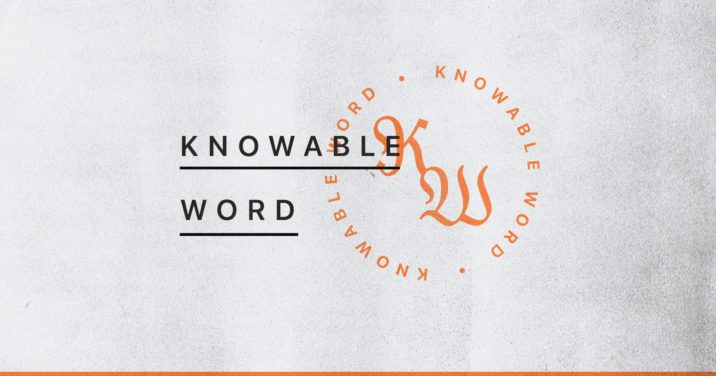Why are we here, and what is our purpose? What on earth went wrong, and why are things so messed up? How can we go about making this wrecked world a better place?
These are some of the most important questions a person can ask. If we’re willing to be honest about the answers, they will inject our existence with great confidence and hope. The first book of the Bible is, literally, a book of beginnings, as “Genesis” means “beginning.”
The beginnings narrated in this book lay the foundation for everything that follows. This month, we begin a two-part series in the beginning of those beginnings, where we’ll work through Genesis 1–11, both to consider the basic principles of human existence and to sharpen our Bible study skills along the way. Shall we begin?
Week 1: Overview of Genesis
When launching a study of a book of the Bible, we are prudent to get a sense of the whole. And the best way to develop that sense is simply to read the book. I understand that, according to word count, Genesis is the second longest book of the English Bible.1
So this will take some time. But Genesis contains some of the most important and interesting narratives in all of Scripture. This week is your opportunity to find a comfy chair, kick back, and bask in the glory of this literary masterpiece. No need to feel guilty if you don’t stop at every verse to meditate on the deep spiritual truths of God. Your job this week is simply to delight in his glory and beauty, as revealed in this really great story.
As you read, take note of the chief organizational device within the text: the heading “These are the generations of” (ESV, NASB),2 “This is the genealogy of” (NKJV), “This is the account of” (NIV, NLT), or “These are the (family) records of” (CSB). This heading divides the book into a number of epic tales.
To help you capture the shape and drama of each epic, I recommend the following reading schedule:
Day 1: Genesis 1:1-2:3
Day 2: Genesis 2:4-6:8
Day 3: Genesis 6:9-11:26
Day 4: Genesis 11:27-25:11
Day 5: Genesis 25:12-35:29
Day 6: Genesis 36-41
Day 7: Genesis 42-50
After you’ve read the book: How many times did you find the heading? What is the outline of those sections? See Study Note [A] at the end if you’d like some help. Though our current two-part series will cover only 11 chapters of Genesis, you’ll see from the outline that those 11 chapters make up half of the sections in the book. The narratives we’ll examine here are brief but dense, perhaps making up half of the book’s overall message.
Week 2: The First Creation
In the beginning, God created the heavens and the earth. With those words, humanity’s understanding of this world was forever changed. But how did God do it? And why did he do it in this way? The first chapter (plus 3 verses) of Genesis establishes vocabulary and a pattern that will require the rest of the Bible to unpack.
Read Genesis 1:1–2:3 a few times. Take note of the structure and any repeated patterns you observe. Observing the structure simply means dividing the text into sections based on literary clues. Don’t overthink it. This one should not be too difficult to subdivide; I don’t expect it to take an entire seven-day week for you to figure it out. What repeated phrases mark the beginning and end of each section? See note [B] if you need some help.
Authors propel narratives forward primarily through the use of conflict, increasing tension, climax, and resolution. Go back now to the first few verses of the chapter and try to identify: What is the chief conflict? In other words, where does the text first create a feeling of tension that requires resolution or a solution? See note [C]. Do not lose sight of this narrative tension. Genesis 1 has been the subject of endless debates and controversies.
Our goal in Bible study is not to form an opinion on every possible controversy, but to understand the biblical author’s main point. And the main point of a narrative will be intimately woven into the conflict and climax of the plot. So let’s make sure not to miss those things.
What is the chief conflict? In other words, where does the text first create a feeling of tension that requires resolution or a solution?
Now that you’ve identified the source of conflict or tension, how does the following sequence address those issues? How does God address the earth’s formlessness? How does he address its emptiness? How does he address its darkness?
One day’s narrative gets a lot more space than any of the other days. Why do you think that is? What happens on that day unique from all the others? How does this part of the text bring the introductory conflict to a climax? In other words, what is God’s ultimate solution to the formlessness, emptiness, and darkness? What role will God play in the ongoing solution to these problems? What role will others play? Why can God finally rest on the seventh day?
How does the mandate God gives humanity give direction and deeper meaning to your own life? In what ways can you image God by shaping the formlessness in your world? How can you image him by filling the empty spaces? And how would he have you shine light into the darkness? These are your created purposes.
What does Jesus have to do with any of this? See note [D].
Week 3: A Place for Mission
We come now to the first occurrence of the heading (“These are the generations of …”). That word “generations” or “account” refers to what comes out, or results, from something. So “the generations of the heavens and the earth” are the things that came out of, or resulted from, the creation of the heavens and the earth in the previous chapter.3 In chapter one, we saw the creation of the cosmos in six days. Now we get a little more localized and particular.
Read Genesis 2:4-25 a few times. Whereas chapter 1 was structured by chronology (a sequence of seven days), chapter 2 is structured geographically. Can you divide the text into sections based on where things take place?
We ought to notice more parallels with the plot of chapter 1 as well. In that chapter, the main conflict had to do with God addressing three unfinished matters with the initial creation of the earth (Gen 1:2). In chapter 2, we have a similar problem-and-solution approach to the plot conflict.
The first problem (v. 5) is that there is no bush or small plant yet “in the land.” What causes are given for this problem? What solutions arise as you continue reading? How many different solutions must he work through before one finally sticks? See note [E].
The second problem (v. 18) is that the man is alone, without help. He cannot do what he has been called to do (vv. 15–17) by himself. What solutions arise as you continue reading? How many different solutions must he work through before one finally sticks?
What has God called you to do as a human? As a Christian? What resources are at your disposal as gifts from God to accomplish your task? How has he provided you with reliable help?
Week 4: The First Fall
We started well enough in paradise, but there’s a long way to fall from there. Time to look at what really went down.
Read Genesis 3 a few times. Take care to observe the characters and how they are portrayed. What are they named or called in the text? When do they receive those names or titles? How do the characters develop from the chapter’s beginning to its end? See note [F].
What are the serpent’s tactics in tempting the woman? What should have happened rather quickly (see Genesis 2:15)? Why does God pursue Adam and Eve with questions (vv. 8–13) when he is God and presumably already knows the answers? See note [G].
How is the punishment for each suspect (serpent, v. 14–15, woman, v. 16, man, v. 17–19) fitting to their crime? What did God say would happen if they ate the fruit (2:17)? What happens instead? See note [H].
How does the man respond, and why (v. 20)? What does God do as a result (vv. 21–24)? What do these things teach us about God and his response to human sin? See note [I].
How does this story help you to understand your sin, temptation, and the grace available to you through faith?
Week 5: The Second Fall
Genesis 2 established a cosmic geography: A garden on a mountain, surrounded by the land of Eden, with water flowing out to the four corners of the world. Last week, we saw the first fall—a sin of disbelief and rebellion—committed in the garden. Now we move out to the surrounding land for the second fall.
Read Genesis 4 a few times. The chapter presents three scenes, each introduced with the parallel phrase: “[Man] knew his wife.” It is easy to get bogged down in this chapter with minor details or questions we have that the text won’t answer for us. Instead of allowing yourself to get distracted by such matters, try to identify the climax or main idea of each of the three scenes. Then we’ll try to figure out how they flow from one scene to the next.
In the first scene, what do the woman’s words (or lack of words) communicate about her hopes for each of her sons? Why might she have such expectations (look back at 3:15)? How do those sons live up to those expectations? The classic question with this story is, “Why did God accept Abel’s offering and not Cain’s?” That’s not a terrible question, but can be a bit misleading: Look closely at the text of vv. 4 and 5. The Lord’s regard was not only (or even first) for the offerings. What was his primary regard for or against?
When Cain finally experiences the regard of the Lord toward him (v. 15), what is the result (v. 16)? Is that the sort of regard one should want? Why or why not?
In the second scene, what happens when a society sprouts from the seeds of Cain’s self-centeredness? How do we see such sprouts in human history? How do we still see them today?
In the third scene, what is the Lord’s answer to the problem of Cain and his ilk? See note [J]. How might such a solution help us with the spiritual descendants of Cain’s tribe today (those who reject Christ)?
Week 6: The Third Fall
We’ve seen the rebellion of unbelief in the garden, and the family strife and murder in the land. Time to see what happens out in the world. Read Genesis 5:1–6:8 a few times.
This passage begins with a genealogy, which is one of those parts of the Bible we love to skip. But surely it is here for a reason.
What overall rhythm and repetition occur in the genealogy? How does the narrative of the first and last generations depart from the pattern? Where else do you observe deviation from the pattern? What do these observations suggest about why the genealogy is here? (Hint: What are the most commonly repeated words? How do the deviations help unpack the meanings of those words?)
Now take a closer look at 6:1-8. There is much historic debate as to whether the romantic partners here are supernatural beings with human women, or descendants of Seth with descendants of Cain, or something else altogether. From the context of the narrative flow up to this point, which perspective makes the most sense to you? Defend that perspective from the text itself.
Regardless of your precise identification of “sons of God” or “daughters of men,” one thing is abundantly clear in the text: We are dealing with something on a global, or even cosmic, scale. Observe the superlatives (“all,” “every,” “the earth,” etc.) and consider: We had a faithless rebellion in the garden, followed by family strife and fratricide in the surrounding land. Now we have a global intermarriage, leading to extensive judgment (“I will blot out man from the face of the land” – v. 7). Keep these three falls in mind because they will come back into play in part two of our study.
For now, how does this episode make your heart ache for a savior? For a new heaven and earth? For a new beginning? How does Revelation 21:1–8 speak to your longing and answer it through Jesus Christ?
Study Notes
[A] The heading occurs ten times, in Genesis 2:4, 6:9, 10:1, 11:10, 11:27, 25:12, 25:19, 36:1, 36:9, 37:2. A similar phrase, “This is the book of the generations,” occurs in Genesis 5:1. This produces the following outline of sections:1. Introduction: God’s creation in the beginning – 1:1–2:3
2. The generations of the heavens and the earth – 2:4–6:8
3. Possibly subdivided into 2:4–4:36 and 5:1–6:8
4. The generations of Noah – 6:9–9:29
5. The generations of the sons of Noah – 10:1–11:9
6. The generations of Shem – 11:10–26
7. The generations of Terah – 11:27–25:11
8. The generations of Ishmael – 25:12–18
9. The generations of Isaac – 25:19–35:29
10. The generations of Esau (that is, Edom) – 36:1–8
11. The generations of Esau – 36:9–37:1
12. The generations of Jacob – 37:2–50:26
[B] Genesis 1:1–2:3 is structured as a sequence of seven days. Each day, except the seventh, begins with, “And God said,” and ends with, “And there was evening and there was morning, the Xth day.” These repetitions serve the purpose of separating out verses 1–2 as an introduction and 2:1–3 as the conclusion.
Recommended Resources for Further Study of Genesis 1-6
Genesis: A Commentary, Bruce Waltke with Cathi Fredricks, Zondervan, 2001.
The Gospel of Genesis: Studies in Protology and Eschatology, Warren Austin Gage, Wipf & Stock, 2001.
***
This article was originally published in the January/February 2022 issue of Bible Study Magazine. Slight adjustments, such as title and subheadings, may be the addition of an editor.
Related articles
- Bible Genealogies and Geography in Genesis
- What Is the Pentateuch? Plus 15 Best Commentaries for Studying It
- “See to This”: The Meaning of “Jehovah Jireh” in Genesis 22
Related resources
Knowable Word: Helping Ordinary People Learn to Study the Bible
- Jeremiah is the longest. Interestingly, though Psalms—with its 150 chapters—may appear to be the longest, it is only third-longest when measured by number of words.
- In the rest of this study, I will quote the ESV, but you are free to use the translation of your choice.
- Similarly, “the generations of Terah” in 11:27 refers to the story of Abraham, Terah’s son. And “the generations of Isaac” in 25:19 is the story of Jacob, Isaac’s son.






